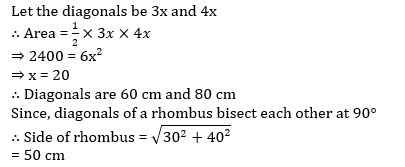Teaching Exam > Teaching Questions > Diagonals of a rhombus are in the ratio 3 : 4...
Start Learning for Free
Diagonals of a rhombus are in the ratio 3 : 4 and its area is 2400 cm2 Side of the rhombus is
- a)20 cm
- b)40 cm
- c)50 cm
- d)100 cm
Correct answer is option 'C'. Can you explain this answer?
Verified Answer
Diagonals of a rhombus are in the ratio 3 : 4 and its area is 2400 cm2...

Most Upvoted Answer
Diagonals of a rhombus are in the ratio 3 : 4 and its area is 2400 cm2...
The given information states that the diagonals of a rhombus are in the ratio 3:4 and the area of the rhombus is 2400 cm^2. We need to find the length of the side of the rhombus.
Let's consider the diagonals of the rhombus. Let the length of the shorter diagonal be 3x and the length of the longer diagonal be 4x.
We know that the area of a rhombus is given by the formula: A = (d1*d2)/2, where d1 and d2 are the lengths of the diagonals.
Substituting the given values, we have: 2400 = (3x*4x)/2
Simplifying further, we get: 2400 = 6x^2
Dividing both sides of the equation by 6, we have: 400 = x^2
Taking the square root of both sides, we get: √400 = x
Therefore, x = 20
Now that we know the value of x, we can find the length of the side of the rhombus.
The diagonals of a rhombus bisect each other at right angles, dividing the rhombus into four congruent right-angled triangles. Each of these triangles has a base equal to half the length of the shorter diagonal (3x/2) and a height equal to half the length of the longer diagonal (4x/2).
Using the formula for the area of a triangle (A = (1/2) * base * height), we can calculate the area of one of these triangles and then multiply it by 4 to find the total area of the rhombus.
Area of one triangle = (1/2) * (3x/2) * (4x/2) = (3x^2)/4
Total area of the rhombus = 4 * (3x^2)/4 = 3x^2
Substituting the value of x, we get: Total area = 3 * (20^2) = 3 * 400 = 1200 cm^2
However, the given area of the rhombus is 2400 cm^2. It appears that there is a contradiction in the given information, as the calculated area does not match the given area.
Therefore, it is not possible to determine the length of the side of the rhombus based on the given information.
Let's consider the diagonals of the rhombus. Let the length of the shorter diagonal be 3x and the length of the longer diagonal be 4x.
We know that the area of a rhombus is given by the formula: A = (d1*d2)/2, where d1 and d2 are the lengths of the diagonals.
Substituting the given values, we have: 2400 = (3x*4x)/2
Simplifying further, we get: 2400 = 6x^2
Dividing both sides of the equation by 6, we have: 400 = x^2
Taking the square root of both sides, we get: √400 = x
Therefore, x = 20
Now that we know the value of x, we can find the length of the side of the rhombus.
The diagonals of a rhombus bisect each other at right angles, dividing the rhombus into four congruent right-angled triangles. Each of these triangles has a base equal to half the length of the shorter diagonal (3x/2) and a height equal to half the length of the longer diagonal (4x/2).
Using the formula for the area of a triangle (A = (1/2) * base * height), we can calculate the area of one of these triangles and then multiply it by 4 to find the total area of the rhombus.
Area of one triangle = (1/2) * (3x/2) * (4x/2) = (3x^2)/4
Total area of the rhombus = 4 * (3x^2)/4 = 3x^2
Substituting the value of x, we get: Total area = 3 * (20^2) = 3 * 400 = 1200 cm^2
However, the given area of the rhombus is 2400 cm^2. It appears that there is a contradiction in the given information, as the calculated area does not match the given area.
Therefore, it is not possible to determine the length of the side of the rhombus based on the given information.

|
Explore Courses for Teaching exam
|

|
Question Description
Diagonals of a rhombus are in the ratio 3 : 4 and its area is 2400 cm2Side of the rhombus isa)20 cmb)40 cmc)50 cmd)100 cmCorrect answer is option 'C'. Can you explain this answer? for Teaching 2025 is part of Teaching preparation. The Question and answers have been prepared according to the Teaching exam syllabus. Information about Diagonals of a rhombus are in the ratio 3 : 4 and its area is 2400 cm2Side of the rhombus isa)20 cmb)40 cmc)50 cmd)100 cmCorrect answer is option 'C'. Can you explain this answer? covers all topics & solutions for Teaching 2025 Exam. Find important definitions, questions, meanings, examples, exercises and tests below for Diagonals of a rhombus are in the ratio 3 : 4 and its area is 2400 cm2Side of the rhombus isa)20 cmb)40 cmc)50 cmd)100 cmCorrect answer is option 'C'. Can you explain this answer?.
Diagonals of a rhombus are in the ratio 3 : 4 and its area is 2400 cm2Side of the rhombus isa)20 cmb)40 cmc)50 cmd)100 cmCorrect answer is option 'C'. Can you explain this answer? for Teaching 2025 is part of Teaching preparation. The Question and answers have been prepared according to the Teaching exam syllabus. Information about Diagonals of a rhombus are in the ratio 3 : 4 and its area is 2400 cm2Side of the rhombus isa)20 cmb)40 cmc)50 cmd)100 cmCorrect answer is option 'C'. Can you explain this answer? covers all topics & solutions for Teaching 2025 Exam. Find important definitions, questions, meanings, examples, exercises and tests below for Diagonals of a rhombus are in the ratio 3 : 4 and its area is 2400 cm2Side of the rhombus isa)20 cmb)40 cmc)50 cmd)100 cmCorrect answer is option 'C'. Can you explain this answer?.
Solutions for Diagonals of a rhombus are in the ratio 3 : 4 and its area is 2400 cm2Side of the rhombus isa)20 cmb)40 cmc)50 cmd)100 cmCorrect answer is option 'C'. Can you explain this answer? in English & in Hindi are available as part of our courses for Teaching.
Download more important topics, notes, lectures and mock test series for Teaching Exam by signing up for free.
Here you can find the meaning of Diagonals of a rhombus are in the ratio 3 : 4 and its area is 2400 cm2Side of the rhombus isa)20 cmb)40 cmc)50 cmd)100 cmCorrect answer is option 'C'. Can you explain this answer? defined & explained in the simplest way possible. Besides giving the explanation of
Diagonals of a rhombus are in the ratio 3 : 4 and its area is 2400 cm2Side of the rhombus isa)20 cmb)40 cmc)50 cmd)100 cmCorrect answer is option 'C'. Can you explain this answer?, a detailed solution for Diagonals of a rhombus are in the ratio 3 : 4 and its area is 2400 cm2Side of the rhombus isa)20 cmb)40 cmc)50 cmd)100 cmCorrect answer is option 'C'. Can you explain this answer? has been provided alongside types of Diagonals of a rhombus are in the ratio 3 : 4 and its area is 2400 cm2Side of the rhombus isa)20 cmb)40 cmc)50 cmd)100 cmCorrect answer is option 'C'. Can you explain this answer? theory, EduRev gives you an
ample number of questions to practice Diagonals of a rhombus are in the ratio 3 : 4 and its area is 2400 cm2Side of the rhombus isa)20 cmb)40 cmc)50 cmd)100 cmCorrect answer is option 'C'. Can you explain this answer? tests, examples and also practice Teaching tests.

|
Explore Courses for Teaching exam
|

|
Signup for Free!
Signup to see your scores go up within 7 days! Learn & Practice with 1000+ FREE Notes, Videos & Tests.


















